

The surge of activity in laser projectors over the last several years, has had a transformative impact on maintenance and cost of ownership and we can expect the evolution to continue until lasers dominate. But laser projectors have not replaced lamped projectors in all applications. For the highest end custom installations like those in museums and theme parks, systems designers have many variables to balance—screen size and shape, room architecture and throw distance, expectations of resolution and brightness, content type, and more. In these extreme environments, lamp-based projectors are still critical to the tool kit.
At the simplest level, choice is often about cost. For many installations that require big, bright, unique pictures, laser projectors often (but not always) won’t survive budget reality. Little by little that’s changing, especially for applications that require only one big gun projector.
But what about an installation that—for example–requires 14 projectors to serve a single enormous screen? This was the case for the new “Through the Eyes of a Hero” theater at the Heroes & Legends attraction at Florida’s Kennedy Space Center Visitor Complex. In that case, Electrosonic’s projection designer Niel Overton worked with the Boxer 4K30–one of Christie Digital’s newest and most powerful projectors at the time the design was conceived. The projectors were deployed in stereo (Left Eye/ Right Eye) pairs to project onto a roughly 220-degree screen. Since 3D famously sucks a fantastic amount of light, the Boxer had the firepower to fill the wraparound, concave screen.
The Boxer 4K30 is a 30,000 lumen, 4K 3DLP projector with six-lamp Mercury illumination. Overton says it was critical that the Boxer 4K30 is omnidirectional (and light at 160 lbs.) He oriented the projectors in portrait, to accommodate the room height and hide them from the audience.
“We were going into an existing space that was almost too small for what they wanted to do,” Overton explains. The short throw to the screen required custom Jenoptik lenses. The 3D system utilized the Infinity 3D server from 7th Sense, which does not require a silver screen as it is not polarized.
“It gives a much better, flatter, cleaner image, there’s almost non existent cross talk, no ghosting into other eye.” Overton says he as a rule prefers the color fidelity of Xenon projectors (“it’s the closest thing we’ve got to the full spectrum light we’re used to seeing.”) But the longer life of the Mercury lamp and other efficiency features of the Boxer 4K30 suited the large-scale 4K/3D application. He’s also optimistic that RGB laser projectors will deliver an increasingly viable cost-benefit ratio in the relatively near future.
“We’re not to the point that we can go solely with laser projectors,” Overton says. “But clients are asking for them. One example is the Pier 57 installation in New York, where the client sprang for a Christie D4KLH60 RGB projector head supported by seven rack-mounted laser modules to fill a massive, pitched screen in the historical building. The projector head is native 4K (4096 x 2160) resolution at 60Hz and can be supported with up to 60,000 lumens with Christie’s scalable laser illumination. Christie claims HDR and a color gamut that replicates Rec. 2020 through the company’s TruLife electronics. The projection system locates the illumination source into rack-mounted, individually cooled laser modules— each of which produces up to 5000 lumens of white light. Up to 12 laser modules can be combined.
RGB laser projection was also right for the Naval Aviation Memorial Giant Screen Theater. The 325-seat theater shows “The Magic of Flight” a film tracing the history of aviation. Originally supported with a lamped projector, the foundation recently upgraded from a film projector to a Christie CP42LH RGB laser projector head.
Phillip Crabtree, operations manager for visitor attractions at the Naval Aviation Foundation, credits the upgrade with over $200,000 in annual cost of ownership savings (on film prints, lamps, royalties and maintenance costs) and a 20 percent increase in attendance resulting from the positive press and word of mouth from the upgraded picture.

As Christie’s most advanced RGB laser system, the Solaria CP42LH head is a natural replacement for a film system; it delivers a color gamut that exceeds the DCI P3 color and replicates Rec. 2020. Crabtree says he learned about Christie laser systems from his colleague Derek Threinen at the National Infantry Museum, who had used two Christie Solaria CP42LH 6P projectors (integrated by D3D Cinema) for their giant screen 3D theater. Threinen was sold by the modular laser illumination, with its scalability and redundancy.
So while RGB laser may not yet be cost effective for a 14-screen attraction, it is making inroads in the large format world of giant screens and custom attractions.










